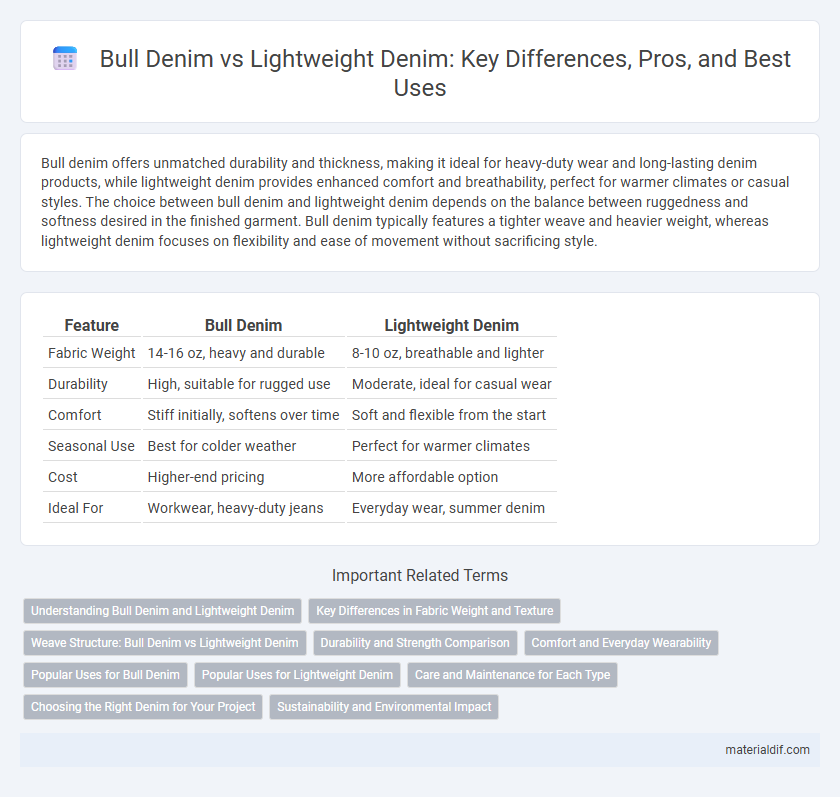Bull denim offers unmatched durability and thickness, making it ideal for heavy-duty wear and long-lasting denim products, while lightweight denim provides enhanced comfort and breathability, perfect for warmer climates or casual styles. The choice between bull denim and lightweight denim depends on the balance between ruggedness and softness desired in the finished garment. Bull denim typically features a tighter weave and heavier weight, whereas lightweight denim focuses on flexibility and ease of movement without sacrificing style.
Table of Comparison
| Feature | Bull Denim | Lightweight Denim |
|---|---|---|
| Fabric Weight | 14-16 oz, heavy and durable | 8-10 oz, breathable and lighter |
| Durability | High, suitable for rugged use | Moderate, ideal for casual wear |
| Comfort | Stiff initially, softens over time | Soft and flexible from the start |
| Seasonal Use | Best for colder weather | Perfect for warmer climates |
| Cost | Higher-end pricing | More affordable option |
| Ideal For | Workwear, heavy-duty jeans | Everyday wear, summer denim |
Understanding Bull Denim and Lightweight Denim
Bull denim features a heavy-weight construction, typically over 14 oz per square yard, providing exceptional durability and resistance ideal for workwear and rugged applications. Lightweight denim, usually ranging from 6 oz to 10 oz per square yard, offers increased breathability and flexibility, making it suitable for casual wear and warmer climates. Understanding these weight distinctions is crucial for selecting denim that balances comfort, performance, and longevity based on specific usage needs.
Key Differences in Fabric Weight and Texture
Bull denim typically features a heavier fabric weight, ranging from 14 to 18 ounces per square yard, providing enhanced durability and a coarser texture ideal for rugged use. Lightweight denim, often weighing between 5 to 10 ounces, offers a softer, more breathable feel suited for warmer climates and casual wear. The significant difference in fabric weight directly influences the texture, durability, and comfort, with bull denim exhibiting a stiff hand and pronounced weave, while lightweight denim delivers a smoother, more flexible finish.
Weave Structure: Bull Denim vs Lightweight Denim
Bull denim features a robust twill weave structure with a higher thread count, creating a dense and durable fabric ideal for heavy-duty use. Lightweight denim employs a looser weave with fewer yarns per inch, offering enhanced breathability and flexibility suited for warm weather or casual wear. The distinct weave structures affect texture, strength, and drape, making Bull denim more rigid and resistant compared to the soft, breathable nature of lightweight denim.
Durability and Strength Comparison
Bull denim is renowned for its exceptional durability and strength, achieved through a denser weave and heavier weight fabric, making it ideal for heavy-duty workwear and outdoor use. Lightweight denim, while more breathable and flexible, typically sacrifices some tensile strength and abrasion resistance, making it less suitable for rigorous activities. The robust construction of bull denim ensures prolonged wear and resistance to tears, contrasting with the comfort-focused design of lightweight denim.
Comfort and Everyday Wearability
Bull denim is known for its durability and rugged texture, making it ideal for heavy-duty wear but less breathable for all-day comfort. Lightweight denim offers superior softness and flexibility, enhancing comfort and ease of movement for everyday activities. Choosing lightweight denim ensures better breathability and comfort, perfect for casual wear without sacrificing style.
Popular Uses for Bull Denim
Bull denim, known for its heavyweight and durability, is popular for workwear, outdoor apparel, and heavy-duty jackets that require robust fabric to withstand tough conditions. Its thick weave makes it ideal for items subject to frequent wear and tear, such as utility pants, carpenter jeans, and rugged outerwear. Lightweight denim, in contrast, is preferred for casual shirts, summer jeans, and fashion-focused pieces where comfort and breathability are prioritized.
Popular Uses for Lightweight Denim
Lightweight denim, typically made with thinner yarns and a lower fabric weight ranging from 3 to 8 ounces per square yard, is popular for summer clothing, casual shirts, and dresses due to its breathability and comfort. Unlike bull denim, which is heavier and more durable for workwear and rugged outerwear, lightweight denim is favored in fashion-forward apparel that requires flexibility and a softer hand feel. Its adaptability makes it ideal for layering pieces and garments intended for mild weather conditions.
Care and Maintenance for Each Type
Bull denim, known for its heavyweight durability, requires minimal washing to preserve its stiffness and shape, recommending spot cleaning and air drying to prevent fading and fabric weakening. Lightweight denim demands more frequent gentle washing at low temperatures to maintain softness and prevent shrinkage, with line drying preferred over machine drying to avoid damage. Both types benefit from avoiding bleach and harsh detergents, but bull denim's robust fibers allow for less delicate care routines compared to the more sensitive nature of lightweight denim fabrics.
Choosing the Right Denim for Your Project
Bull denim offers durability and a heavier weight ideal for rugged workwear and outerwear projects requiring long-lasting fabric, while lightweight denim provides enhanced breathability and flexibility for casual clothing or warm-weather garments. Consider project requirements such as strength, comfort, and seasonality when selecting denim; heavy Bull denim suits high-stress applications whereas lightweight denim supports ease of movement and temperature regulation. Choosing between these denim types depends on balancing durability with comfort to match the specific demands of your design and intended use.
Sustainability and Environmental Impact
Bull denim, known for its durability and heavyweight construction, typically requires more resources and energy during production, resulting in a higher environmental footprint compared to lightweight denim. Lightweight denim utilizes less cotton and energy, reducing water consumption and chemical use, which contributes to a more sustainable and eco-friendly fabric option. Choosing lightweight denim supports sustainable fashion by minimizing resource depletion and lowering greenhouse gas emissions throughout the garment lifecycle.
Bull denim vs Lightweight denim Infographic

 materialdif.com
materialdif.com